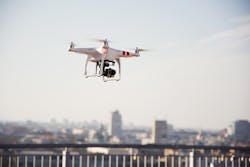Earlier this year, a man who opposed plans by the Japanese government to restart nuclear reactors piloted a drone carrying radioactive sand onto the roof of the prime minister’s office in Tokyo. No one was injured as a result of the incident, but it hammered home the threats posed by the use of unmanned aerial vehicle (UAV) in the wrong hands. Drones are inherently difficult to detect, but there are solutions available from companies that can provide advanced warning a drone may be hovering nearby.
One of those companies is Drone Labs, whose “Drone Detector” product can detect a wide range of both commercial and recreational drone aircraft. According to Drone Labs CEO Zain Naboulsi, a Microsoft veteran who co-founded the company along with Philip Wheat, the company originally set out to develop agricultural drones but after looking at the market, they felt there was a real need for drone detection solutions and decided to shift gears.
Although they have more grandiose plans for their product, Naboulsi said that the current generation of Drone Detector leverages both audio and RFID detection technology to notify users to presence of drones in their area.
“We have fine-tuned our products to work specifically with recreational and commercial drones. We do not detect military drones, we have no plans to detect military drones, that’s not our space,” said Naboulsi. “But, in the recreational and commercial space, we absolutely want to make sure we have the best product available so we have engineered our product to work with the top manufacturers, most notably DJI, 3DR and Parrot products which we’ve hyper-focused on and then, of course, a couple of other minor manufacturers.”
By focusing on those particular drone manufacturers, Naboulsi said they know they can account for almost 90 to 95 percent of the drone market. While the company started out by selling it product through retail outlets, Naboulsi said that the majority of their sales are now exclusively business-to-business.
“Our customer nowadays is security companies and distributors. We have security companies that buy from us and then they either integrate it with other products or take it as is and sell it to their customers,” added Naboulsi.
The unit itself comes with a NEMA-certified container along with a pole mounting kit for easy installation. The range at which the solution can detect a drone depends upon the methodology being used.
With audio and standard microphones, Naboulsi said they can detect a drone from about 50 to 100 feet away and, in a quiet environment that range could be extended up to 200 feet or 300 feet at the most. Drone Labs is currently in the process of testing an omnidirectional microphone, which could expand that audio detection range much further. With RFID, Naboulsi said their detection range is 400 meters, however, in testing it has detected drones at distances up to 600 meters.
In the future, Drone Labs has plans to add even more layers of detection technology to their product.
“What we’re ultimately going to implement is what I like to call the ‘five senses,’” explained Naboulsi. “We’re going to have the audio, we’re going to have the radio frequency and then we’re going to have video, thermal and, ultimately, radar.”
Although there are other drone detection products on the market, Naboulsi said that the majority of them do not incorporate radio frequency technology and lean primarily on audio detection, which can be very unreliable under certain conditions.
“What I’m seeing is proliferation of audio drone detectors out there and it’s pretty obvious why it’s happening. It’s extremely cheap to implement, doesn’t take a whole lot of technical knowledge as opposed to radio frequency detection, which requires an enormous amount of skill, and the barrier to entry is quite low,” he said. “If you’re talking about audio detection, an audio detector being used to protect a crowd of people with a lot of cheering and noise from drones… that’s not going to work. Audio detection tends to fail in urban environments, in general, but more specifically at things like stadiums or events of any kind where people are yelling. A drone makes the equivalent sound of like a hive of bees and sure, when you’re up close, you can hear it just fine.”
Despite the number of high-profile incidents in the U.S. where drones were found to have breached security, Naboulsi said that they do much more business internationally than in the U.S. He believes the restrictive rules that had been in place in the U.S. regarding drone use initially and the subsequent relaxing of those rules may have caught many people off guard.
While he believes that drones and their potential benefit to humanity is great, Naboulsi thinks that it is only a matter of time before someone switches the payload of one of these UAVs from a camera or political letter to something much more deadly.
“In my mind, the end result of this is going to be a drone with Semtex, C4 or something that is flown very close to someone to kill them or a biological agent is attached to the drone for delivery,” said Naboulsi. “Imagine a water supply, it’s very protected, lots of fences, lots of security and a drone just flies right over it and drops something into the water. That’s the kind of stuff we’re dealing with today and that’s the nature of the threat we’re talking about. There are bad people who are going to do bad things with drones and, ultimately, the end game for the bad guys is killing people with drones. On that day, that will be when everybody really wakes up.”



